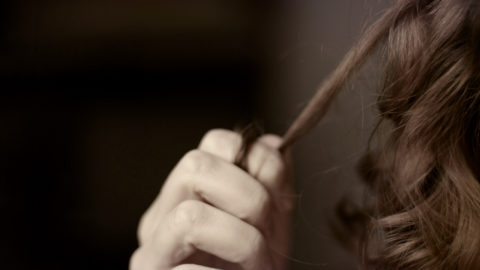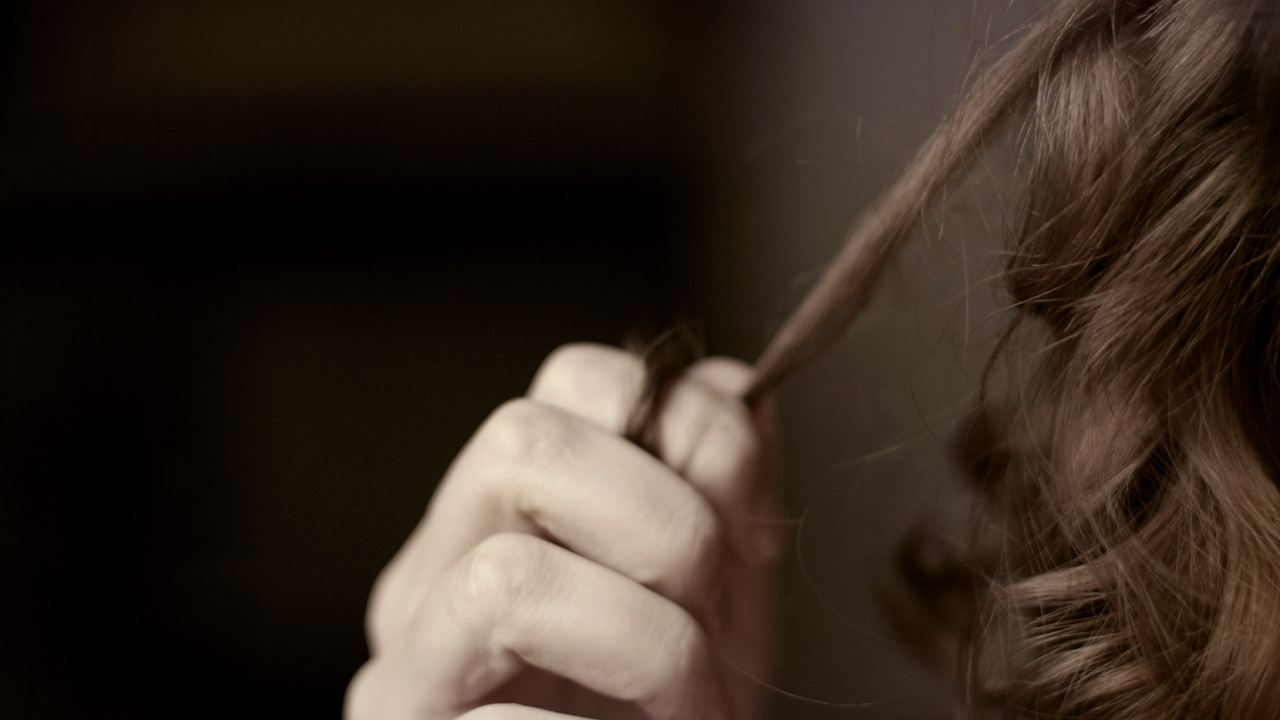I Pull My Hair Out—This Is What It’s Like Having Trichotillomania
And it's gotten more severe during COVID-19

Trigger Warning: This story contains mentions of trichotillomania and hair-pulling.
I was in the 9th grade when Jessica,* a close relative of mine, told me she had broken up with her razor and taken to tweezing her underarm hair instead. “It hurts a little at first, but it actually feels so good,” she explained, adding that pulling out the hairs provided her with a sense of satisfaction. I recoiled in horror upon hearing this, knowing just how painful plucking could be. Who in their right mind finds PLEASURE in pulling out their own hair? I thought to myself. That is, until I tried it that same year. I started with a pair of tweezers on my eyebrows, then my underarms, and eventually a spot on the crown of my head where pulling with my fingers got the job done. The next thing I knew, I was pulling out hair when I was stressed, tired and sometimes when I was just plain bored on the couch watching Lizzie McGuire reruns, deriving great pleasure from almost each strand plucked. (IMO, hairs that are wiry and coarse tend to yield a greater sense of satisfaction, and are way more fun to examine, than those that are pin straight.)
Sometimes I’d mess around with my hair for what felt like five minutes, only to realize a whole half hour had gone by. And while it always felt great in the moment, meticulously searching for the perfect strand to pull, there was one thing Jessica never warned me about: The intense feelings of shame and guilt I’d experience after each binge.
What exactly is hair pulling?
Hair pulling, formally known as trichotillomania or “trich” for short, is a body-focused repetitive behaviour (BFRB). ”We think of trich as an OCD-related disorder,” says Dr. Joanne Leung-Yee, a psychiatrist at Sunnybrook’s Frederick W. Thompson Anxiety Disorders Centre in Toronto, who cites skin picking and cheek chewing as other common BFRBs. Nail biting, something I also habitually do, is also considered a BFRB, although it doesn’t carry the same stigma as trich.
People with trich feel the irrepressible urge to pull out their hair for non-cosmetic reasons, finding the feeling soothing. Common areas to pull from include the scalp, eyebrows and eyelashes for women, and scalp and beard for men. “Sometimes this compulsion comes with other behaviours,” Leung-Yee says, like rubbing the plucked hair over the lips, examining the hair root and bulb, and chewing on or eating the hair.
It often gets to the point where those who suffer from trich feel embarrassed and distressed by the fact that they are unable to stop. If you’re reading this and thinking, Why don’t you just stop?!—it’s not that simple. “For those who don’t have a BFRB, [think of it] as an itchy mosquito bite that’s 100 times more intense,” Leung-Yee says. “You can stop it in the moment if someone tells you not to itch it, but that itch and bite will still be there; that urge will still be there.”
How common are BFRBs like hair pulling?
According to Leung-Yee, BFRBs affect up to 5% of the world’s population, while only 1 to 2% have OCD (which is noteworthy, given the fact that OCD is a lot more normalized than BFRBs). BFRBs like trichotillomania usually start during the teenage years and are believed to be genetic. “If you had a huge family reunion with all of your aunts and uncles, chances are you’d see some of them playing with their hair or biting their nails,” Leung-Yee explains.
Why do people pull out their hair?
So, why do people hair pull? “That’s the million dollar question,” Leung-Yee says. “If we knew why people pull then we could actually target a treatment for it.” Aside from the genetic connection, some experts think BFRBs may be triggered by childhood trauma, although how the trauma connects to the act of pulling is not so clearcut. Ultimately, BFRBs like trich serve as a stimulating or soothing mechanism. “If you’re really bored, you may use a BFRB to give you a sort of stimulation,” Leung-Yee says. “And on the other hand, if you’re overstimulated—if you feel really anxious or angry—you may use a BFRB to make you feel a little more soothed or calm.”
How do people with trich hide it?
People with trich will go to great lengths to hide the habit. I know from experience: I was able to hide my hair pulling from my loved ones up until university, simply by parting my hair differently. Others will don hats, scarves and wigs to avoid detection, and even put off trips to the hair salon for fear of judgement. “There’s a lot of shame and a lack of understanding surrounding trich, and that’s one of the most painful parts,” Leung-Yee says. It’s especially hard for women, she says, as men will usually shave their heads or beards after pulling.
Is COVID-19 affecting trich?
As soon as COVID-19 came around, I put a halt on gnawing at my fingernails, for fear of virus transmission. The downside? My now perfectly manicured fingers have been spending a lot more time in my scalp.
Likewise, Leung-Yee has noticed the impact of COVID on her patients’ progress. Pulling is a rather private act, so WFH life makes it much easier to go on a spree. Additionally, people tend to hair pull in certain areas of the home, like in front of the TV or in bed. “While you might have been someone who pulled after work or at bedtime, now that you’re home all the time you can go into your bedroom whenever [you want] and pull.”
Then there are the video conference calls. “Often, a trigger can be looking in the mirror and seeing that one off-coloured or kinky hair,” Leung-Yee says.
Being told to stay home can also justify pulling. “It’s like, ‘Oh I’m not going out anywhere, nobody is gonna see me, so I might as well,’” she says. Overall, COVID-19 has been an unusually stressful situation, so if you’re a stress-puller, and you’ve been binge pulling, you’re not the only one.
Is there a cure for trich?
Unfortunately, there is no magic pill that can rid you of the urge to pull. A 2009 American study found that the over-the-counter supplement N-acetylcysteine, derived from the amino acid L-cysteine, helped reduce urges in nearly 60% of participants. That said, the study had a small sample size and was conducted over a decade ago and scientific research since has been scant. Leung-Yee has many patients who take the supplement and has noticed about 30% of her patients responding to it, and while that’s something, she stresses that the most effective and trusted way of managing trich is through cognitive behavioural therapy (CBT), whether in groups or solo. “It’s a lot of work, and it’s hard, but it’s effective and we see a huge improvement.”
Becoming more aware of the urge to pull can also help manage the disorder. Leung-Yee gets her patients jingly bracelets, which act as an audible reminder to not pull when their hands start wandering. Similar to her method, I have a bracelet with the word “stop” on it to help keep me in check, and I always keep a giant scrunchie on my wrist in case I need to throw my hair up in a top knot to avoid touching it.
Thankfully, the shame, guilt and stigma around trich is slowly lifting
I’ll never forget the embarrassment and shame I felt when my parents found out about my trich. I was in my early 20s when my mom questioned the bald spot on my head. Like most things, no matter how hard you try to hide it, eventually someone will notice. I tried to brush it off as nothing, but was so mortified about being caught that I ended up coming clean right then and there. There wasn’t much information available online at the time; now there are forums, Facebook groups, Reddit threads and even Instagram meme accounts that act as a space for those with trich to openly discuss their problems and progress.
Leung-Yee says her patients are coming in and seeking help a lot quicker now—most of them are in their early 20s—as opposed to older generations. With the abundance of information online, those closest to you can also easily educate themselves on trich. Leung-Yee runs a group session for family and friends on how they can become more helpful. Nowadays, I’m quicker to talk to my loved ones about my struggle, and it also helps to know that I’m not alone in my journey.
*Name has been changed






